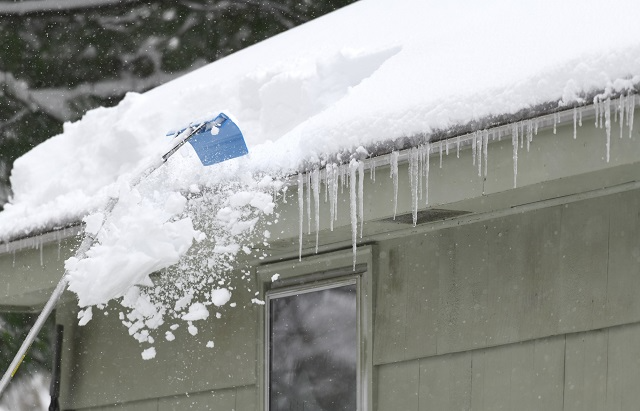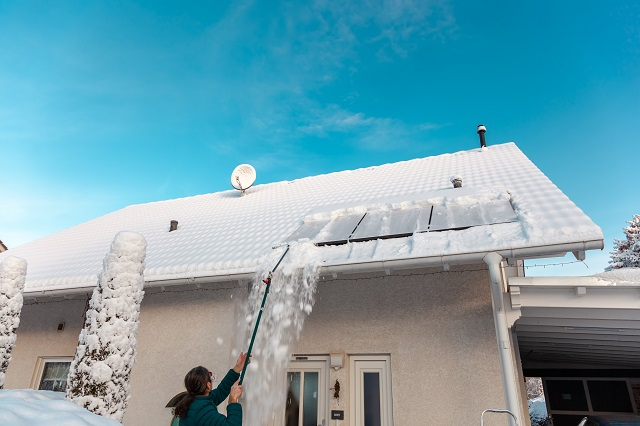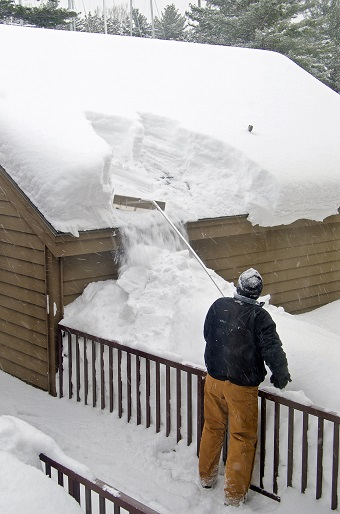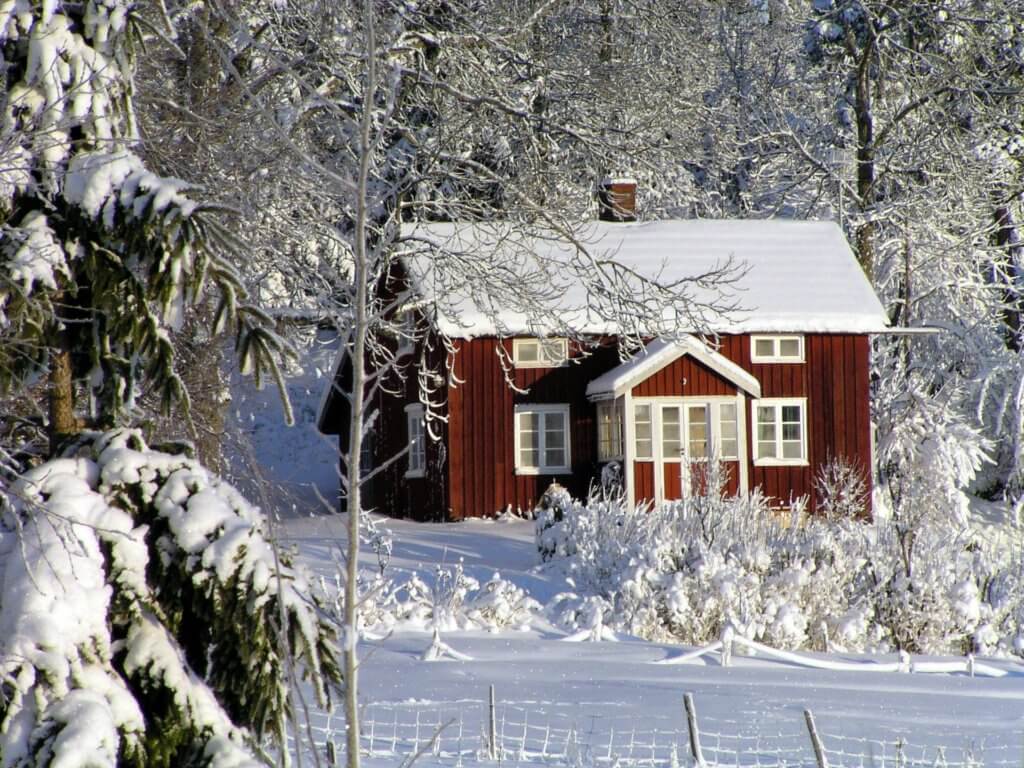New England winters hit hard with snow and ice. This can be a festive sight during the holidays but also create an unwanted chore for homeowners. On top of shoveling your driveway and scraping ice off your windshield, your roof also needs attention to keep it free of snow.
Building codes generally require new roofs to be able to withstand 30 pounds per square foot. However, a heavy snowfall can accumulate quickly, leading to more weight than your roof was meant to handle. Clearing snow off of your roof can help prevent ice dams, as well.
Excess weight on your roof could lead to structural collapse. Removing snow from your roof periodically can help prevent this disaster.
It’s not recommended to climb up on top of your roof to shovel snow. This is where a roof rake comes in handy. Similar to a roof snow shovel, a roof rake for snow is a specialized tool designed to safely and effectively clear snow from your roof without the risk of climbing a ladder or walking on a slippery roof.
In this guide, we’ll explain what a roof rake is, how to use one, and safety precautions to consider before removing snow from your roof.
In this article:
- Types of Roof Rakes
- How Do Roof Rakes Work?
- How to Use a Roof Rake
- Safety Considerations
- Frequently Asked Questions
Types of Roof Rakes

There are a number of variations of roof rakes. All roof rakes feature a long handle and a horizontal piece of plastic or aluminum at the end that guides the snow off the roof. Some have rollers or gliders that create a gap between the rake and roof in order to minimize damage to your shingles.
The different roof rake types include:
- Flat-Blade Roof Rake: A flat-blade roof rake features a lengthy handle with a flat blade head designed to scrape snow from the roof. This flat blade may be plastic, aluminum, or foam and is wide enough to act like a shovel for your roof.
- Scoop-Blade Roof Rake: Like the flat-blade roof rake, a scoop-blade roof rake features a long handle but instead of a flat blade head, the end is in a scoop shape to better remove larger amounts of snow.
- Adjustable Roof Rake: Most roof rakes are adjustable in some way. Some models only adjust to one or two different lengths, while others can extend anywhere from 5 feet up to 30 feet.
- Sliding Roof Rake: A sliding roof rake helps the snow slide better off the roof. Plus, it helps the roof rake to glide easily over your roof so it doesn’t damage your shingles. These roof rakes are outfitted with a long sheet or chute that clears a lot more snow (and faster) in one sweep than a traditional roof rake.
- S-Style Roof Rake: A roof rake with an S-style design has a blade end that’s wavy – neither flat nor scooped. This in-between design is made for the push-and-pull method of removing snow from the roof.
The Eversprout Never-Scratch SnowBuster is a good choice for the S-style blade head. Made from soft foam, this roof rake is made for all types of surfaces, including skylights and solar panels. Featuring a pole that extends up to 12 feet, the Eversprout SnowBuster is one of the lightest roof rakes on the market.
How Do Roof Rakes Work?

Roof rakes have a long handle, typically made from aluminum so it’s sturdy but lightweight, with a horizontal piece attached to the end. The pole averages about 20 feet in length, though most rakes are adjustable, and some have non-slip, rubberized grips for easy handling.
Roof rakes are ideal for removing snow from your roof because they don’t involve unsafe activities like climbing a ladder or walking atop your slippery, snow-covered roof. They’re designed so you can stand firmly on the ground below while alleviating the heavy weight of snow from your roof’s edges.
A well-made roof rake allows you to comfortably pull snow down from the roof but stay out of harm’s way. The Snow Joe 21′ Twist-n-Lock Telescoping Snow Roof Rake is a top choice for removing snow from a roof because it features a wide, poly plastic blade and extends up to 21 feet. It’s lightweight but sturdy and easy to handle.
How to Use a Roof Rake
It’s important to choose the right roof rake for the job you need done. Choose a roof rake that measures the correct height so you can reach as much of your roof as possible. Steps to take to ensure you use the roof rake correctly include: 
- Inspect your roof: Though it could be difficult to fully inspect your roof while it’s covered in snow, give it a once over so you don’t accidentally do more damage to an already vulnerable part of your roof. This can help you avoid accidentally pulling off loose shingles or gutters.
- Be mindful of nearby obstacles: Just like inspecting your roof, look over your immediate surroundings before you start. Do not work near power lines and be careful of low-hanging branches or roof obstacles like weather vanes or vents.
- Wear protective gear: You probably won’t forget your winter coat, but make sure your gloves fit properly so you can keep a good grip on the roof rake. Consider a hard hat or protective eyewear, such as these durable safety glasses from DeWALT, in case of falling ice.
- Start at the roof’s edge: Sweep snow off your roof beginning at the edges (and knock those icicles down first), working your way toward the middle of your house. This helps lighten the heavier load of snow away from the more vulnerable parts of your roof. Leave about 2 inches to 3 inches of snow in order to protect your home and prevent damage to shingles.
- Get out of the way: It may seem obvious, but get out of the way of falling snow. Raking snow from the roof can cause a mini avalanche, and if the snow is mixed with water or ice, it could cause injury. As you pull the snow from your roof, step to the side so it doesn’t fall directly on you.
Safety Considerations
Even though there isn’t as much risk as there is with climbing ladders carrying a shovel or walking along a steep roof covered in snow and ice, that doesn’t mean raking your roof is completely risk-free. If you’re at all concerned about the risk or dangers involved, consult a roofing professional to clean your roof for you.
Don’t rush the process of removing snow from your roof. It may not be as back breaking as shoveling can be but it still requires physical demand.
Take breaks as needed so you don’t overexert yourself or cause muscle strain. Be careful regarding the ground you’re standing on and the boots you’re wearing so you can easily maneuver around the snowy ground.
Final Thoughts
At Ranch Roofing, we’re open year-round to help our customers with their roofing issues. Whether you need minor roof repairs after storm damage, a full roof replacement, skylight replacement and installation, or you’re unsure what services you need to address a roofing issue, give us a call or schedule a free estimate today.
Frequently Asked Questions
When should you use a roof rake?
A roof rake is an ideal way to shovel snow off your roof. If your roof appears to be sagging from the weight of snow or if your roof is somewhat flat, you should remove what snow you can to alleviate the pressure on your home.
Consider hiring a roofing professional to safely and effectively remove snow from your roof, especially if your roof has multiple levels or is particularly steep in places.
Are roof rakes worth it?
It is worth having a roof rake on hand for those times you must get snow off your roof immediately. It’s best to know what type you need for your home and how to use it before you actually need it.
A good budget pick is the Gymax Snow Roof Rake. This is one of the best roof rakes for snow because this model has a wide, flat, aluminum head to clear a large amount of snow in each pass and is outfitted with rollers to minimize damage to your roof. Adjust the length of the pole from 5 feet to 20 feet to reach multiple heights.
Does roof raking damage shingles?
If done incorrectly, scraping snow off your roof could damage the shingles. It’s recommended to leave a buffer of 2 inches to 3 inches of snow on your roof so you don’t accidentally hit your shingles and cause them to break or loosen. Some models of roof rakes are equipped with rollers or gliders so there remains a gap between the rake and roof.
How do I choose a roof rake?
Choose a roof rake based on your needs and your home’s design. You need to know the height of your roof to determine the length of rake you need. Many roof rakes are adjustable so you’re able to reach various heights with one rake.
Consider the material, shape, and size of the rake’s blade head. Plastic and foam are gentler on your roof but may not be as sturdy as aluminum.
For lighter jobs, an S-shape foam head provides the least risk of roof damage while still being effective. For heavy-duty jobs, consider a flat-blade or scoop-blade made from aluminum or plastic.
